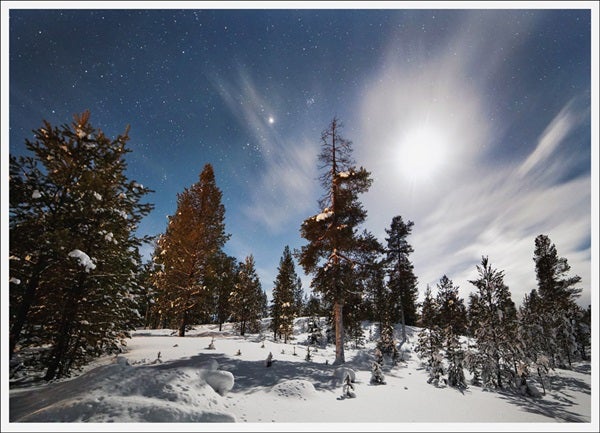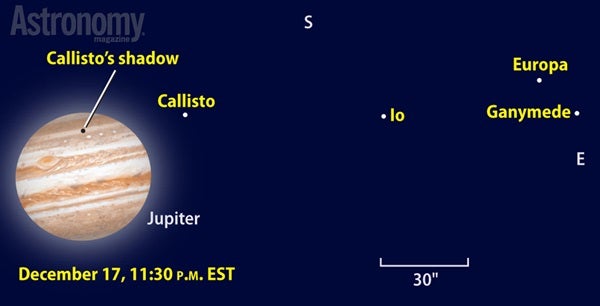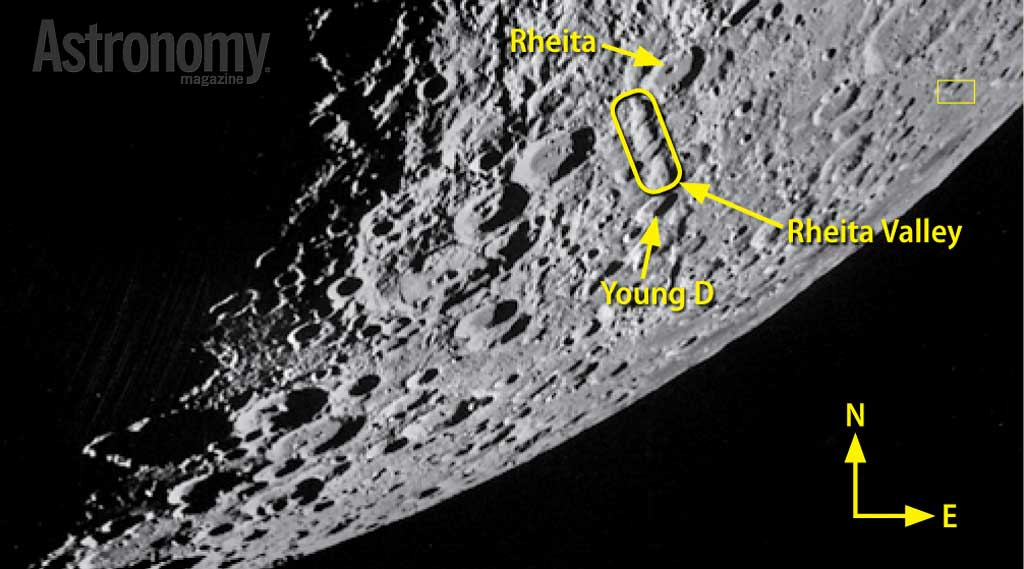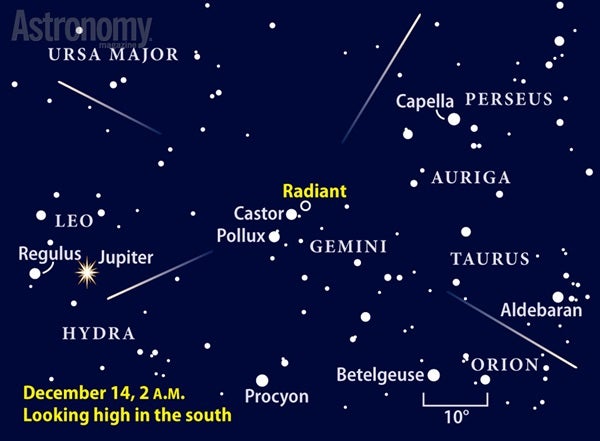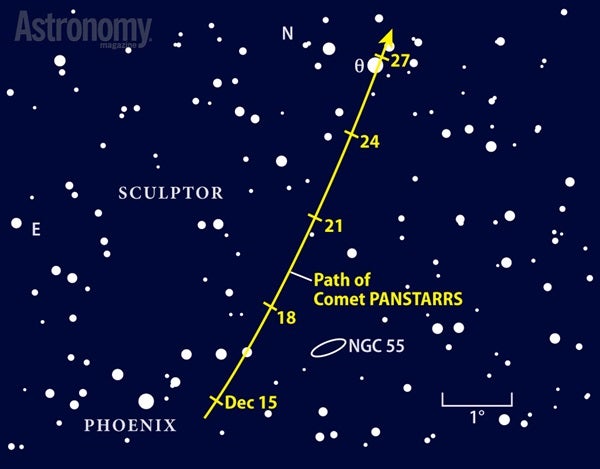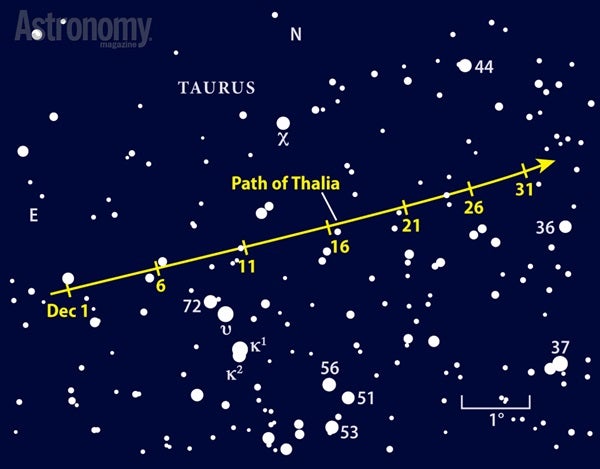Later in the evening, Jupiter pokes above the eastern horizon and becomes conspicuous well before midnight. As the giant planet wheels into the western sky in the wee hours, Saturn climbs into view shortly ahead of the approaching dawn.
Early evening skywatchers should first set their sights on Mars. The Red Planet lies some 20° above the southwestern horizon an hour after sunset throughout December. It crosses the border from Sagittarius into Capricornus on the 4th and remains within the Sea Goat through year’s end. At magnitude 1.0, Mars shines five times brighter than Capricornus’ brightest sun, magnitude 2.8 Delta (δ) Capricorni. You can compare the two directly in late December when the planet moves to a spot just 3° west of the star.
Mars sets more than three hours after the Sun all month. Although this might seem like plenty of time to examine it through a telescope, the view will prove disappointing. The planet’s disk measures a mere 5″ across and likely won’t show any detail.
Venus returns to view in mid-December after a three-month hiatus. On the 15th, it appears 3° high in the southwest a half-hour after sunset. If it weren’t so bright (magnitude –3.9), you’d be hard-pressed to spot it. Even so, binoculars will give you the best chance to find it against the bright sky. By month’s end, Venus stands twice as high and shows up much more easily in the twilight glow.
As with Mars, a telescope doesn’t much improve the view of Mercury or Venus. On the 31st, Mercury spans 5″ and the Sun illuminates 92 percent of its disk; Venus’ disk appears twice as big as its neighbor’s and is 96 percent lit.
Draw an imaginary line between Venus and Mars, and you’ll be tracing a small portion of the ecliptic — the Sun’s apparent path across the sky that the planets follow closely. Continue this line past Mars to find the location of our next planet, distant Neptune. You’ll need binoculars or a telescope to find this magnitude 7.9 world among the background stars of Aquarius the Water-bearer.
As December opens, Neptune stands about 40° above the southern horizon as darkness falls. Start your search high in the south with the Great Square of Pegasus, then shift your gaze roughly 25° to the lower right and look for the tight collection of five stars that forms the Water Jar asterism. This group’s brightest sun is magnitude 2.9 Alpha (α) Aquarii; magnitude 3.7 Zeta (ζ) Aqr marks the asterism’s center.
Center Zeta in your binoculars, and then scan about 10° due south — the brightest star in this location is magnitude 4.8 Sigma (σ) Aqr. Neptune lies less than 1° west of Sigma all month. A telescope reveals the planet’s blue-gray disk, which spans 2.3″. Neptune sets before midnight local time in early December and close to 9 p.m. by month’s end, so don’t wait too long to track it down.
Don’t confuse Uranus with 96 Piscium, a similarly bright star just 1° north-northeast of the planet. A telescope makes them easy to identify — 96 Psc appears as an orange point of light, while Uranus sports a blue-green color on a 3.6″-diameter disk.
Jupiter rises around 10 p.m. local time in early December and two hours earlier by month’s end. The giant planet shines at magnitude –2.3 at midmonth, making it the brightest point of light in the night sky. It spends December among the stars of western Leo the Lion. Jupiter’s eastward motion early in the month carries it to within 7° of 1st-magnitude Regulus by the 9th. The planet then reverses direction, however, and its westward travels take it to a point 8° from Leo’s brightest star by the 31st.
The solar system’s largest world has a massive atmosphere consisting mostly of hydrogen and helium. A telescope reveals a richly detailed riot of activity atop these cloud layers. You’ll first notice a series of parallel bands — light-colored zones alternating with darker belts — that stretch from the equator well into the mid-latitudes. With patience at the eyepiece, you’ll start to notice turbulence at the boundaries of these bands. Also look for the Great Red Spot, a conspicuous blemish that shows up when it’s on the hemisphere facing Earth. These features should appear more prominent during the course of December as the planet’s apparent diameter swells from 40″ to 43″.
The visual treats at Jupiter extend beyond the atmosphere to include the planet’s four bright moons. The plane of these so-called Galilean satellites tilts edge-on to Earth and the Sun once every six years or so, and we’re now in the midst of one of these rare alignments. During this period, observers with telescopes can watch as one moon passes in front of another (an occultation) or one moon passes through another’s shadow (an eclipse).
start time. At the peak of the occultation, the combined light of the two moons drops by 20 percent.
Another exciting mutual event takes place in front of Jupiter the morning of December 23. Europa occults Io near the jovian disk’s center at around 5:15 a.m. EST. Europa’s shadow first appears on the planet’s cloud tops at 1:44 a.m. EST, followed by Io’s shadow at 3:05 a.m. Europa itself starts transiting the planet’s disk at 3:42 a.m., with Io trailing just 20 minutes behind. Innermost Io closes the gap between the two moons over the next 75 minutes, when they appear to merge above Jupiter’s Equatorial Zone. The bright background will make the moons hard to resolve — most instruments will show them as an elongated pair.
Although these mutual events add a lot of spice to observing the Galilean moons, these four worlds deliver a satisfying meal every clear night. Track their disks and shadows on the frequent occasions when they transit Jupiter’s cloud tops, or simply watch as they change relative positions during the course of a few hours.
Our final planet comes into view before dawn after December’s first week. Saturn climbs higher day by day, and by the 31st, it appears 20° high in the southeast an hour before sunrise. At magnitude 0.6, it shines noticeably brighter than Scorpius’ brightest star, Antares, which appears some 10° below it.
Although the view through a telescope suffers because of the ringed planet’s low altitude, Saturn is always worth a quick look. On the 31st, it appears 16″ across while the rings span 35″ and tilt 25° to our line of sight.
Earth reaches its winter solstice at 6:03 p.m. EST on December 21. At that moment, the Sun lies farthest south in our sky, among the invisible stars of northern Sagittarius. The solstice marks the beginning of winter for people north of the equator and summer for those in the Southern Hemisphere.
The Moon’s frozen face records the scars of its past life: bombardment from above and volcanic activity from below. The prominent impact crater Copernicus and its surroundings provide a nice introduction to this dual nature. When the crater lies on the terminator, the line that divides sunlight from darkness on the lunar surface, its high walls stand out above the surrounding plain. Sunrise over this complex region occurs twice in December, on the 1st and 31st.
View the sunlit (eastern) side of Copernicus, and you’ll see richly textured terrain that looks like the aftermath of a small rock landing in a bowl of pudding. Secondary craters, formed when blast remnants fell back to the surface shortly after the main impact, dot the landscape. On Copernicus’ western side, a bunch of jumbled peaks stick out above a surface flooded with lava.
The smaller crater Hortensius sits right along the terminator to Copernicus’ west. Examine the region just north of Hortensius, and you’ll find a cluster of six volcanic domes, little bumps each with its own shadow. They show up only when the Sun lies near the lunar horizon. Each dome appears to be about 4 miles across and 1,000 or so feet high. If observing conditions are superb, a 6- to 10-inch telescope should reveal tiny summit pits on several of these domes. Despite advances in lunar geology over the past few decades, astronomers still don’t know precisely how these domes formed.
Just a couple of hours later, the Sun’s rays glance across another large dome just west of the neighboring crater Milichius. Lunar observers can spend hours watching the play of light and dark as the Sun rises over this region. You can get equally stunning views under reverse lighting conditions at lunar sunset on the mornings of December 15 and 16.
The cold nights of December feature two notable meteor showers. The more famous and prolific Geminids peak during the morning hours of the 14th, while the often-overlooked Ursids reach maximum on the 22nd.
A Last Quarter Moon occurs the same day as the peak of the Geminids, but that’s not the bad news it may appear. First, the shower produces lots of bright meteors, diminishing the Moon’s effect. And second, the Geminids is one of the few showers that delivers lots of meteors before midnight. The streaks of light appear to radiate from the constellation Gemini, which climbs high in the sky by late evening before the Moon rises.
The Ursid shower typically produces only 10 percent as many meteors as the Geminids, but it peaks this year under nearly ideal New Moon conditions. Ursid meteors appear to streak from a point in the constellation Ursa Minor.
| WHEN TO VIEW THE PLANETS |
||
| Evening Sky |
Midnight | Morning Sky |
| Mercury (southwest) |
Jupiter (east) |
Jupiter (southwest) |
| Venus (southwest) |
Uranus (west) |
Saturn (southeast) |
| Mars (southwest) |
|
|
| Uranus (southeast) |
|
|
| Neptune (south) | |
|
After autumn’s cornucopia of comets, the pickings this winter are comparatively meager. Still, at least one is worth pursuing. Comet PANSTARRS (C/2012 K1) has a nice conjunction with the edge-on barred spiral galaxy NGC 55 in Sculptor from December 17 to 19.
Wait until midmonth to track down this comet. Not only does moonlight interfere during the first part of December, making cometary detail harder to see, but PANSTARRS also travels northward quite rapidly this month, moving higher into the early evening sky.
The comet should fade to 9th magnitude during December as it moves away from both the Sun and Earth and its dust production quiets down. PANSTARRS should appear as a round fuzzball compared with the mottled nature of NGC 55, which glows a magnitude brighter.
Last month, we followed Comet Siding Spring (C/2013 A1). Sadly, it sets during deep twilight in December, glowing around 10th magnitude not far from globular star cluster M14 in Ophiuchus. Try for it if you’ve got superb skies and a flat western horizon.
The Hyades and Pleiades star clusters are among the sky’s most beautiful binocular objects. They remain fascinating in a telescope’s narrower field, where bright stars punctuate the rich background. But the higher magnification adds more than just stars — asteroid 23 Thalia climbs the eastern sky with these clusters on December evenings.
Our target resides in the main asteroid belt between the orbits of Mars and Jupiter. English astronomer John Hind discovered Thalia in December 1852 by noticing the object’s apparent shift relative to the background stars. It was Hind’s eighth asteroid discovery; by the time he was finished two years later, he had found 10 of the first 30 known.
You’ve got it easier than he had it because we can tell you exactly when and where to point your telescope. Start your search in the appropriate region shown on the chart below, and then sketch your telescope’s field of view with three or four reference stars. Return a night or two later to peg the “star” that moved. You can accomplish the same feat on a single night, December 11, when the asteroid shifts position noticeably relative to an 8th-magnitude star.
Martin Ratcliffe provides planetarium development for Sky-Skan, Inc. from his home in Wichita, Kansas. Meteorologist Alister Ling works for Environment Canada in Edmonton, Alberta.

